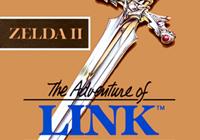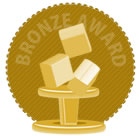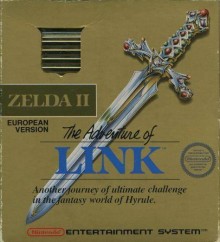Zelda II: The Adventure of Link (NES) Second Opinion Review
By Aria DiMezzo  28.03.2016
28.03.2016

Widely disliked as a part of the franchise, Zelda II: The Adventure of Link certainly is unique, if the CDi games aren't counted (and no one counts the CDi games). It's hard to argue with the contention that this isn't a good Zelda game, but that doesn't necessarily mean it's a bad game. It came in the early days of gaming, when sequels often took radical departures from their predecessors, and it's certainly not as bad as Castlevania II: Simon's Quest. When it all comes together, how does Link's second adventure fare?
The NES has some extremely difficult games - Silver Surfer, Battletoads, Double Dragon III, and Castlevania III: Dracula's Curse - but worthy of standing beside these pinnacles of the term "Nintendo Hard" is the follow-up to The Legend of Zelda. Unlike any other game in the franchise, this is a side-scrolling platformer, and it is extremely challenging - often unfair - thanks to the nuanced combat that this style allows.
The gameplay style isn't the reason that it's distinctly "un-Zelda-like," though; the primary issue is the lack of wonder. From the very beginning, the franchise has been about finding new toys to play with, and using them to find bigger and better things to play with. Zelda II has none of that, and is a straightforward romp from one side of the world to the other. Sure, there are items in the game, but the majority of equipment Link acquires is used passively and automatically. The Magic Hammer and Whistle are the only ones actually usable, and their purposes for exploration are negligible, while they have no use in the side-scrolling combat.
First appearances suggest that this will be very similar to the first game, but after only a second of overhead exploration, some black monsters appear on the map, similar to Ultima: Exodus's port on the NES. The monsters here, however, ignore most terrain and just go wherever they want—over the mountains, through the hills, and onto the sea; nothing impedes them as they saunter casually toward Link.

Then there is an extraordinarily grating sound, and the screen goes black. A moment later, Link stands in a side-scrolling segment, capable of running, jumping, and stabbing - totally unlike anything in the first game. Colourful expletives may accompany a scandalised cry of, "What is this?" but all is not lost: the side-scrolling combat is a lot of fun. There is a nice variety to the enemies, and there's no single strategy that works for every monster.
The dungeons here are essentially like the random encounters, but the screens are much larger. Typical for a Zelda game, there are keys, locked doors, and enemies to be killed. Each palace contains an item and a boss; after defeating the boss, Link can return a crystal to its statue and prevent Ganon from being brought back to life.
As mentioned before, the dungeon items are as superfluous as they could possibly be, and they have negligible impact on gameplay. It wasn't much fun to light up random dark rooms in the first game, but the Candle there also damaged enemies—a fact that is critical to the No Sword Challenge. Here, however, dark caves simply light up automatically. Link also gets a pair of boots that let him walk on water, and they are used without further input, as well, as is the raft. It's all very passive, and therefore not very exciting.
Aside from a few Heart Containers, there is nothing of consequence in the game that even can be missed, so getting the items becomes an uninteresting formality. The Magic Hammer isn't there because there are secrets all over the world to be uncovered by intrepid players; it's there because a boulder blocks the path, and there is no other way around it. Similarly, the Candle isn't there because players want to burn down a forest searching for hidden treasures; it's there because the caves are dark, and the Candle is necessary to proceed. Contrast this to the Blue Candle of the original, which was purchased in a shop, could be used to reveal at least a dozen useful secrets, and which didn't leave progress basically impossible without acquiring it.

The Magic Hammer of A Link to the Past makes another excellent contrast. It's required to proceed, but is also useful in combat, since some enemies can only be made vulnerable with it. In the SNES masterpiece, the Magic Hammer continues to be useful in unlocking secrets and shortcuts through the remainder of the game. In Zelda II, only one boulder blocks the path, and there are only two boulders that block off caves, while using it amounts to waltzing up to a painfully obvious boulder and pressing a button. The rock simply disappears—there's no animation, and only barely a sound effect.
These are the reasons that Zelda II falls short as a Zelda game. Players don't get the Magic Hammer because it sounds like fun to go around bashing things with a hammer while looking for treasures; it's needed to proceed, and then that's that, except for one or two token "secrets." This is a trend that more recent entries into the franchise have fallen into, as well, so maybe future releases will eventually vindicate the flaws of Link's second outing.
There's also an Experience Level system! That's right—the Zelda franchise shoehorned in a level system before every game series threw one in, and it's okay here. Link has three stats: Attack, Magic, and Life. After gaining a specific amount of Experience (the amount needed, of course, increases with each stat boost), Link can increment one of those, starting at Level 1 and taking the stat up to Level 8. It's a different way of accomplishing the same thing that multiple swords and an abundance of Heart Containers normally do for the franchise, and the Magic stat lowers the cost of spells.
Spells could have been much more interesting than they turned out to be, but Link doesn't have a way to restore Magic. Many of its contemporaries had systems that allowed Magic to be regenerated out of combat, and that would have worked very well here. Aside from the Magic Jars that occasionally drop from defeated enemies (which regrettably mean the enemy didn't award any Experience), or letting Link die, there is no way to replenish Magic. Since casting spells is occasionally necessary to proceed, this comes off as cheap.

The high cost of the spells and lack of reliable ways to replenish Magic mean that spells will only be used when necessary—they aren't there to have fun with; they're there simply to make progress. Using the Thunder spell to rain lightning down from the sky and kill all enemies on the screen definitely sounds like it would be awesome. Unfortunately, what really happens is that the screen flashes, every enemy inexplicably dies, and fifty to one hundred percent of Link's Magic meter is depleted. It would be great to use Thunder more freely (and would be fantastic if the spell had accompanying graphical effects), but it's too impractical; that Magic will probably be needed later to cast Fairy to get to the next part of the dungeon.
That's certainly a lot to take umbrage to, but it's not all bad. The combat is fun, difficult, and rewarding, while the overworld is expansive. The overworld is also linear and annoying to traverse, thanks to the random encounters, but the battles are easy ways of racking up the Experience that is critical to survival. Again, though, players won't gain levels because it's fun to become more powerful; they'll gain levels because it's necessary to proceed.
It's linear, then, but it's a fun adventure nonetheless. Castlevania is linear, too, and it's awesome. In fact, the Castlevania series (excluding its second instalment, funnily enough) is a good comparison, even though here there is an overworld with a few caves off the beaten path. The overworld is much more like that of the recent Super Mario 3D World than that of other Zelda games, while the side-scrolling is much more like the older Castlevania games. On its own, this isn't bad, but it's not a good fit for a Zelda game.

Cubed3 Rating
Very Good - Bronze Award

As a Zelda game, the sequel doesn't even fall short of its predecessor, because it instead vaults in another direction entirely, smacks into a wall, stumbles backward, and falls onto its face. However, as an ordinary game, forgetting the name it bears, it's a fun journey, though it is linear and unusually difficult. It isn't on the level of Castlevania III, but it's several orders of magnitude more difficult than any other Zelda game, and includes what is probably the hardest boss fight in the franchise. Many of its elements went on to become staples of the series, so it certainly has its place in history "as a Zelda game," but it will always be an outlier under that venerable mantle, and for good reason.

![]() 7/10
7/10
![]() 8/10
(5 Votes)
8/10
(5 Votes)
 Out now
Out now  Out now
Out now  Out now
Out now  Out now
Out now Comments
Comments are currently disabled

 Sign In
Sign In Game Details
Game Details Subscribe to this topic
Subscribe to this topic Features
Features





 Top
Top

